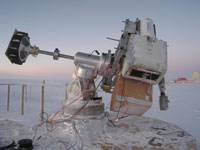
Posted to News on 25th Mar 2011, 00:00
Antarctic temperatures no problem for miniature motor
The Dome C telescope in the Antarctic is in constant use, even under some of the toughest weather conditions on the planet. Key to its operation are rugged geared motors from Maxon.

The Concordia Station (known as Dome C) research station lies in Eastern Antarctica at 3,200m above sea level in one of the coldest places on Earth. Temperatures here fell recently to a new record low of -84.6°C. So it's all the more remarkable that a telescope of the University of Nice's Astrophysics Laboratory (LUAN) has been in constant use for years in this inhospitable place - 24 hours a day, seven days a week.
The telescope is mounted on a motorised base produced by the US company Astro-Physics. The company develops and produces high-precision telescope mounts and has wide experience in all kinds of application areas. Various units from its ranges have been in constant use in the Antarctic since the beginning of 2000. The ability to assure trouble-free, continuous use is of great importance, as maintenance work is extremely difficult and very dangerous to set up. The low temperatures and inhospitable windy conditions make it almost impossible for maintenance teams to work outside and essentially impossible in the Polar night which lasts for six months. This means that the entire system has to run perfectly 24/7 for at least half a year.
The reduction gearing is one of a telescope mount's key features, enabling it to be contin-uously manoeuvred, smoothly, without juddering so that the telescope can give a consistent view of a particular object in the sky. If not, the object quickly disappears from the telescope's field of vision, making it impossible to plot its trace without disruption. In order to 'fix' the object in the field of vision, the heavy mount which weighs around 250kg, has to be motorised.
Wally Piorkowski, head of production at Astro-Physics and himself a scientist, speaks from experience: "Because of their high reliability and longevity, Astro-Physics only uses drives from Maxon Motor for all its telescope mounts." The lubricant used in the bearings is tailored to the extreme temperatures experienced at Dome C in the Antarctic. Once mounted, the Maxon motors require no further lubrication, which is essential as it would be almost impossible given the ambient conditions. The motors also have coreless windings and Neodymium magnets to help deliver maximum performance in a compact construction volume. Graphite or precious metal brushes are used for the motors' mechanical commutation. Their linear characteristics make them very easy to implement in telescope mount applications.
Axes of movement
Every mount has two axes. The right ascension axis is set up parallel to the Earth's axis and allows the telescope to move across the Earth's equator. The motor drives against the Earth's rotation so that the object in the sky appears fixed. The reduction gearing was developed in-house by Astro-Physics. The second axis, known as the declination axis, is arranged at right-angles to the right ascension axis and manoeuvres the telescope intermittently at the object's angular distance to the celestial equator. The motors on both axes are fitted with three-channel encoders.
"We use Maxon A-max motors for our smaller mounts, and Maxon RE 25 motors for telescope mounts such as in Dome C," says Piorkowski. The RE 25 offers maximum torque and power density in its class. "Another major reason for using Maxon motors is the fact that they have no magnetic detent," he adds. Detent is the jerky, sudden movement that typically occurs with most iron-core motors. By contrast, Maxon motors feature an ironless core which enables them to run detent-free, even at extremely low speeds. This is a basic requirement in a telescope mount.
"Mounts are often bought separately from the telescope," explains Piorkowski. "Astronomical associations, colleges and institutes buy telescopic equipment separately from the mount then assemble the two themselves." Astro-Physics' telescope mounts are used in many domestic residences, universities, research institutes and educational establishments, astronomical associations, joint organisations and in solar technology companies.








